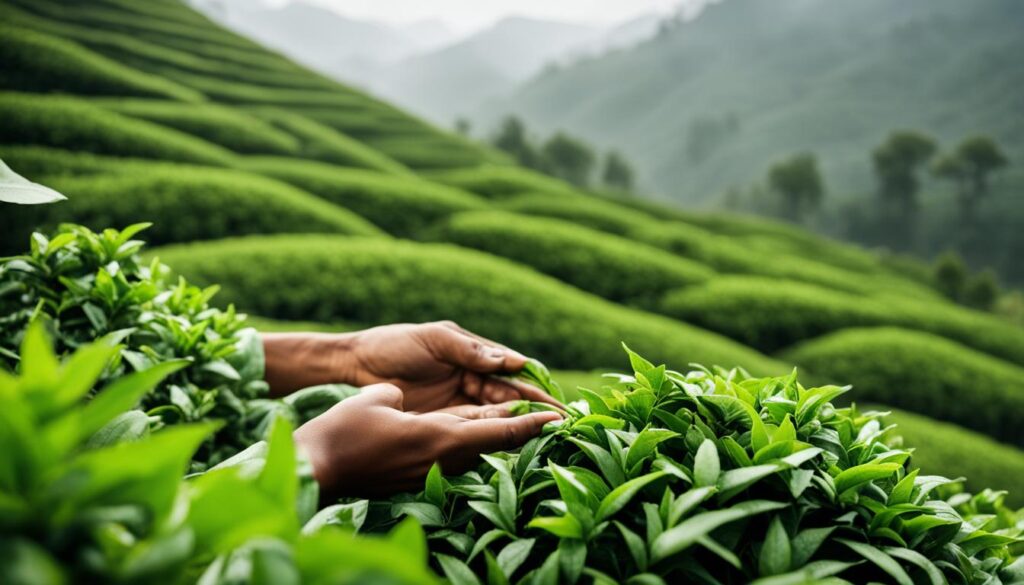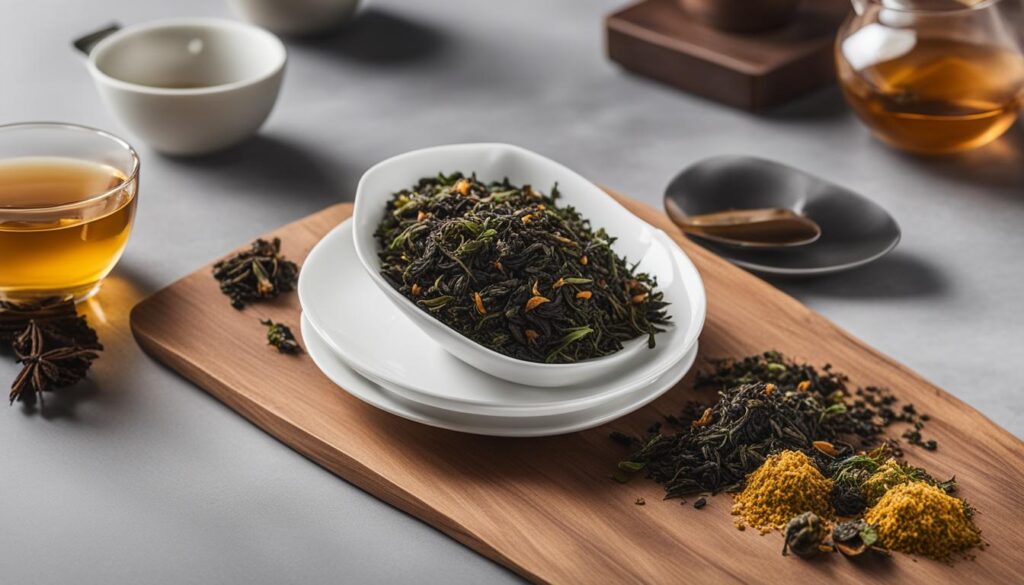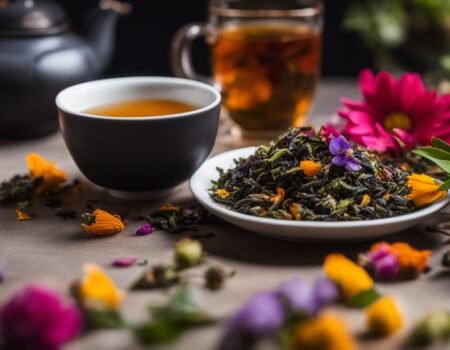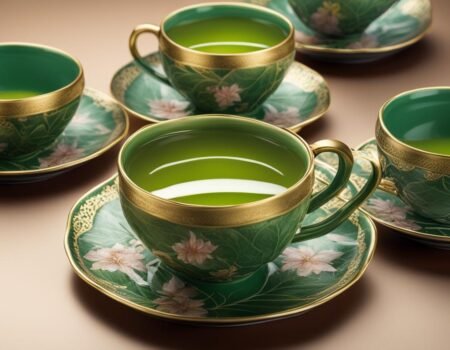
Mastering the Art of Tea with Specialty Tea Tasting Guides
Greetings, fellow tea enthusiasts! Are you ready to embark on a journey of flavor exploration and discover the secrets of tea tasting like a pro? Look no further, because we’ve got you covered with our comprehensive specialty tea tasting guides. Whether you’re a tea connoisseur or a budding tea lover, these guides will equip you with the knowledge and skills to elevate your tea tasting experience to new heights.
Tea tasting is an art that requires practice, patience, and a discerning palate. With our tea flavor identification guides, you’ll learn how to identify and appreciate the subtle nuances and complex flavors of different tea varieties. From the delicate floral notes of a white tea to the robust earthiness of a pu-erh, you’ll be able to decipher the intricacies of each cup with confidence.
But we don’t stop there. Our advanced tea tasting techniques will take your expertise to the next level. You’ll learn how to differentiate between various tea qualities, assess the strength and briskness of a brew, and even master the art of tea blending. With these techniques in your arsenal, you’ll be able to create your own unique tea blends that cater to your personal taste preferences.
Key Takeaways:
- Specialty tea tasting guides enhance your knowledge and skills in tea tasting.
- Tea flavor identification guides help you identify the subtle nuances of different tea varieties.
- Advanced tea tasting techniques enable you to assess tea quality and create your own blends.
- Mastering the art of tea tasting opens up a world of flavor exploration and creativity.
- Stay tuned for more tea-tastic tips and tricks in our upcoming sections!
The Role of Tea Tasting in the Blending Process
Tea tasting is an integral part of the tea blending process, allowing tea masters to create unique flavor profiles. When blending teas, several factors need to be considered, including the quality aspects such as cup color, flavor, strength, and briskness. Additionally, the price and availability of different teas also play a role in the blending process.
While tea blending is less common in China where green leaf teas dominate, visual aspects such as homogeneity, color, and smell are crucial for leaf tea blends. Blending equipment varies depending on the batch size and customization requirements. From small-scale hand blending to large-volume blending machines, tea masters utilize various tools to achieve the desired blend.
Benefits of Tea Blending
“Blending teas allows us to create unique flavor profiles that cater to the diverse preferences of tea enthusiasts. It gives us the opportunity to combine different teas and create harmonious blends that are balanced in aroma, taste, and mouthfeel. The blending process also allows us to experiment and create innovative tea combinations that provide exciting new experiences for our customers.”
By blending teas with herbals, such as flowers and spices, tea professionals can create unique and wellness-focused blends that appeal to health-conscious consumers. These blends often offer additional health benefits and a wider range of flavor profiles. Blending teas not only adds value to the final product but also allows tea tasting businesses to differentiate themselves in the market.
Table: Examples of Tea Blending Equipment
| Blending Equipment | Batch Size | Customization Options |
|---|---|---|
| Tea Mixing Machines | Large | Limited |
| Hand Blenders | Small to Medium | High |
| Roller Blenders | Medium | Medium |
Tea blending not only allows tea professionals to offer a wide variety of unique flavors but also adds an element of artistry to the tea tasting experience.
The Importance of Tea Quality and Sourcing
When it comes to running a successful tea tasting business, the importance of tea quality and sourcing cannot be overstated. Ensuring that the teas you offer to your customers are of the highest quality is crucial to providing a memorable and satisfying tea tasting experience.
One way to guarantee the quality of your teas is by sourcing them as close to home as possible. Direct trade, which involves working directly with tea farmers and producers, allows for better control over the quality of the teas you purchase. It also supports sustainable practices and ensures that the farmers receive fair compensation for their hard work.
Organic and fair-trade teas have gained popularity among environmentally conscious consumers, so it’s essential to include these options in your tea selection. Sourcing from the top 2% of teas produced in the world will further enhance the quality and exclusivity of your offerings.
In addition to sourcing high-quality teas, the freshness of your inventory and the way you blend the teas together can make a significant difference in the overall flavor and aroma. Hand blending allows for greater precision and customization, resulting in unique tea blends that stand out from the competition.
Table: Comparing Tea Sourcing Methods
| Sourcing Method | Advantages | Disadvantages |
|---|---|---|
| Direct Trade | Provides better control over quality Supports sustainability initiatives Builds relationships with farmers Fair compensation for farmers | Higher cost Requires more effort to establish connections Limited availability |
| Auction or Wholesale | Wide variety of teas available Lower cost | Limited control over quality Unknown sourcing practices Potential for lower quality teas |
| Local or Regional Suppliers | Promotes local economy Possible partnerships for events or collaborations | Limited tea options available Quality may vary |
By focusing on tea quality and sourcing, you can provide your customers with a tea tasting experience like no other. From the moment they take their first sip, they’ll be able to taste the difference and appreciate the care and expertise that went into selecting and blending the teas. So go ahead, explore the world of tea, and create a tea tasting business that stands out from the rest.

“Tea quality and sourcing are essential factors in the tea industry. Ensuring high-quality standards by sourcing teas as close to home as possible is crucial for tea tasting businesses.”
Creating a Memorable Tea Tasting Experience
When it comes to tea tasting, creating a welcoming and comfortable environment is essential in providing a memorable experience for customers. The ambiance of the tea tasting space sets the tone for the entire experience, allowing customers to relax and fully embrace the flavors and aromas of the teas they are sampling.
Designing a tea tasting space that reflects the culture and history of tea can enhance the overall enjoyment. Consider incorporating elements such as traditional tea sets, calming colors, and natural lighting to create a serene atmosphere. Comfortable seating and soothing background music can further elevate the sensory experience of the tasting session.
Tea education is another crucial aspect of creating a memorable tea tasting experience. Offering classes, workshops, or even tea clubs can provide customers with opportunities to learn about the origins of different teas, brewing techniques, and the health benefits they offer. Educating customers about the teas they are tasting not only enhances their appreciation but also fosters a deeper connection to the tea tasting business.
Engaging with customers through social media platforms like Instagram can also help build a community and promote the tea tasting business. Sharing photos of the tea tasting space, teas in different stages of production, and behind-the-scenes insights can generate interest and excitement. Encouraging customers to share their own tea tasting experiences and reviews further strengthens the sense of community and establishes the tea tasting business as a go-to destination for tea enthusiasts.

The Benefits of Tea Clubs
One innovative way to enhance the tea tasting experience is through the creation of tea clubs. These subscription-based clubs offer customers the opportunity to regularly explore and discover new teas. Each month, members receive a curated selection of teas along with detailed tasting notes, brewing recommendations, and information about the tea’s origin.
Tea clubs provide a unique and educational experience for customers who want to expand their tea knowledge and explore the world of specialty teas. By introducing members to a variety of teas, including rare and limited-edition blends, tea clubs enable customers to broaden their palate and discover new favorites.
Furthermore, tea clubs foster a sense of community among members. They provide a platform for tea enthusiasts to connect and share their experiences, tasting notes, and brewing tips. This creates a vibrant and engaged community of tea lovers who can support and inspire each other in their tea tasting journey.
Overall, creating a memorable tea tasting experience involves designing a welcoming environment, offering tea education, and engaging with customers through tea clubs and social media. By embracing these strategies, tea tasting businesses can provide customers with an unforgettable journey into the world of tea.
Marketing and Promoting a Tea Tasting Business
When it comes to marketing and advertising a tea tasting business, it’s important to have a comprehensive strategy in place. With the right approach, you can reach your target customers and create a strong online presence. Let’s explore some effective marketing techniques that can help you promote your tea tasting business and attract new customers.
1. Develop an Online Presence
In today’s digital age, having a strong online presence is essential for any business. Start by creating a well-designed website that showcases your tea tasting services, expertise, and unique offerings. Make sure your website is mobile-friendly and easy to navigate.
Additionally, take advantage of social media platforms such as Instagram and Facebook to engage with your audience. Share visually appealing images of tea tastings, tea-related quotes, and educational content. Interact with your followers by responding to comments and messages promptly.
2. Utilize Local Advertising Avenues
While online marketing is crucial, don’t overlook the power of local advertising. Collaborate with other local businesses, such as cafes or wellness centers, to cross-promote your services. Consider placing ads in local newspapers, magazines, or community bulletin boards to reach a wider audience.
3. Participate in Tea-Related Events
Attending and participating in tea-related events can be a great way to showcase your tea tasting business. Set up a booth and offer samples of your teas at local food fairs, farmer’s markets, or tea festivals. This will not only allow you to connect with potential customers but also build relationships with other tea enthusiasts and industry professionals.
4. Offer Incentives and Discounts
To encourage customers to try your tea tasting services, consider offering incentives such as free shipping or discounts for first-time customers. This can help drive traffic to your website and increase customer engagement. Additionally, implement a referral program where existing customers receive benefits for referring new customers to your business.
By implementing these marketing strategies, you can effectively promote your tea tasting business and attract a wider audience. Remember to track your marketing efforts and make adjustments as needed to optimize your success. With dedication and creativity, your tea tasting business can thrive in the competitive tea industry.

Conclusion
So there you have it! The art of tea tasting is a fascinating journey that offers endless opportunities for tea enthusiasts and entrepreneurs alike. With our comprehensive tea tasting manuals and specialized guides, you can confidently navigate the intricate world of tea flavors and aromas.
Whether you’re a seasoned tea connoisseur or just starting out, our tea tasting for beginners guide is designed to help you develop your palate and expand your knowledge. By mastering the techniques of tea flavor assessment, you’ll be able to identify the subtle nuances and complexities that make each cup of tea unique.
As you embark on your tea tasting adventure, remember to create a welcoming and inviting atmosphere for your customers. Combine our expert recommendations with your own personal touch to design a space that reflects the beauty and tradition of tea.
Lastly, don’t underestimate the power of effective marketing and promotion. Utilize the online platforms available to you, build a strong online presence, and engage with your audience. By sharing your passion for tea and providing a memorable tea tasting experience, you’ll create a loyal community of tea lovers who will eagerly return for more.
FAQ
Can anyone become a tea taster?
While anyone can develop their tea tasting skills, becoming a professional tea taster requires extensive practice, training, and a passion for tea. It is a skill that can be honed over time with dedication and experience.
How do tea masters blend teas?
Tea masters blend teas by carefully considering the quality aspects such as cup color, flavor, strength, and briskness, as well as the price and availability of teas. They use their expertise, along with their team’s input, to create unique flavor profiles.
Why is tea quality and sourcing important?
Ensuring high-quality teas by sourcing as close to home as possible is crucial for tea tasting businesses. Direct trade allows for better control over tea quality and supports sustainability initiatives. Customers are increasingly interested in organic and fair-trade teas.
What makes a memorable tea tasting experience?
A memorable tea tasting experience is created by providing a welcoming and comfortable environment that reflects the ambiance and culture of tea. Offering tea education, classes, workshops, and subscription-based tea clubs can enhance customers’ enjoyment and knowledge.
How can I promote my tea tasting business?
You can promote your tea tasting business by utilizing online platforms, social media, and local advertising avenues. Collaborating with other local businesses and participating in tea-related events can also create visibility. Building a strong online presence through an engaging website and content is essential.
Can anyone open a tea tasting business?
Opening a tea tasting business requires careful planning, market research, and a solid understanding of tea tasting procedures and techniques. Passion and knowledge for tea are important, but it takes strategic business skills to build a successful tea tasting enterprise.






